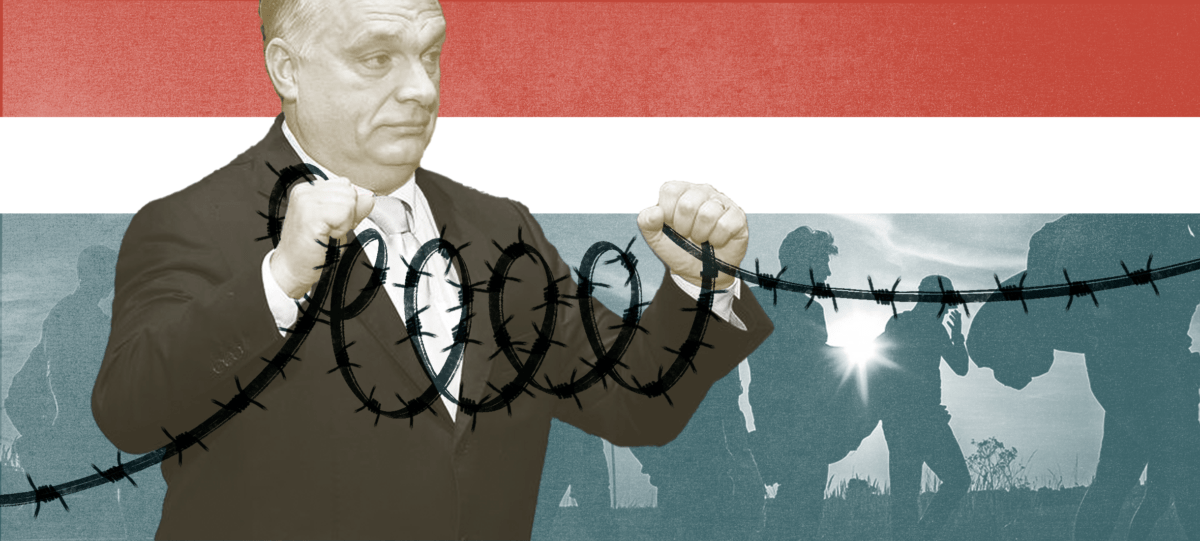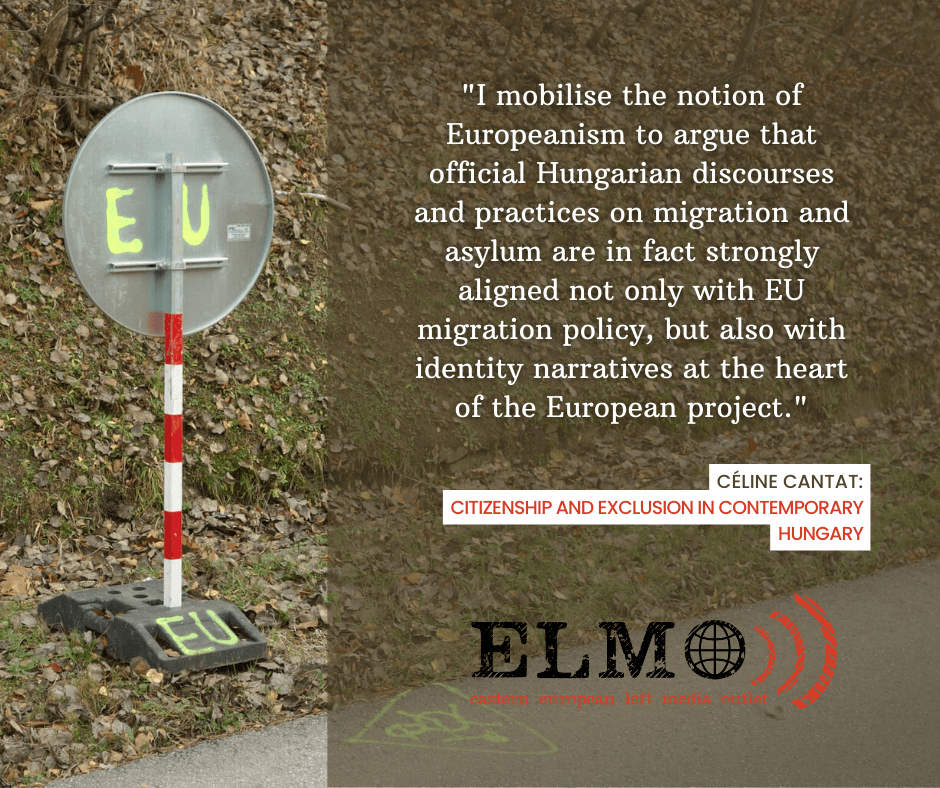
This article is part of the multilingual ELMO series Transnational migration in CEE from intersectional perspectives of race, gender, class and citizenship.
Since the so-called ‘migration crisis’ in 2015, Hungarian Prime Minister Viktor Orbán has become a key figurehead of an ultra-conservative and illiberal European right.[1] This politics is anchored in virulent anti-immigration positions and fierce discourses targeting the European Union (EU), which is pictured as incapable of “protecting Europe and its civilisation” from the “threat” posed by migrants.”[2] Beyond his inflammatory rhetoric, Orbán has consistently opposed EU-wide initiatives on common migration governance, including the European Commission’s proposal to implement quotas for the distribution of asylum seekers, as well as several provisions contained in the 2020 “New Pact on Migration and Asylum.”
These positions have earned the Hungarian PM calls to order from his European counterparts. In 2015, for example, Laurent Fabius, then French Minister of Foreign Affairs, criticised him for failing to “respect Europe’s common values.” In 2018, it was German Chancellor Angela Merkel who judged Viktor Orbán’s speeches on immigration to be lacking in humanity, declaring that “humanity is the soul of Europe.”[3] Hungary’s position on migration has thus been presented as exceptionally exclusionary and as constituting a moral anomaly in the European political landscape. In addition to such moral assessments, commentators have highlighted the contradictory nature of the country’s position in light of its declining population. Indeed, coupled with strong outward migration towards western European markets, Hungary’s demographic dynamics have led to serious labour shortages. In light of this, the country’s opposition to migration and its potential to fill gaps in the labour market is seen as contradictory, and largely irrational.
In this article, I attempt to show that Hungary’s position on international migration is the result of specific power configurations and discursive tensions[4] pertaining to the political, economic, and cultural organisation of the European Union. I mobilise the notion of Europeanism, which I developed in my doctoral work, to argue that official Hungarian discourses and practices on migration and asylum are in fact strongly aligned not only with EU migration policy, but also with identity narratives at the heart of the European project. Then, I suggest that Hungary’s positions on migration are in fact functional to the country’s navigating power relations with European institutions.
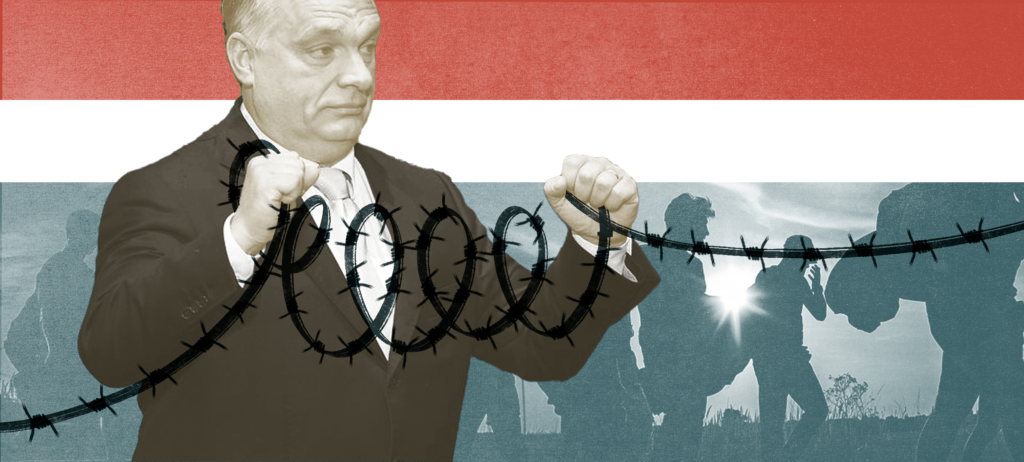
In turn, these considerations show that the country’s migration policies and practices are the products of EU politics, and more particularly of the specific capitalist (re)organisation of the region that accompanied European integration. Indeed, I argue that the establishment of this economic system was accompanied by the production of specific (desirable) subjects and, simultaneously, the dialectical production of undesirable groups. I use the notion of “moral economy” to refer to the processes through which relations of production instantiate specific ideas of virtue and right. Moral economies thus produce regimes of citizenship and belonging that are embedded in and reflect particular economic interests and configurations. Analysing the new moral economies associated with the transition to market-based capitalist economies, helps us better understand the culturalization of social issues, and allows us to think through the reconfiguration of social relations on the basis of new articulations of race, gender, and class.
Hungary in the EU Border Regime: Protector of Europe or Second-Class Member State?
Since the 1990s, Europe’s common immigration and asylum policy has been organised around a two-tier regime: the intra-European zone of free movement is complemented by a regime of exclusionary and security-related external border controls.[5] The targets of security practices are, in particular, people trying to enter the EU to seek asylum. In the course of the 2000s, measures were deployed ranging from the extension of the remit of the European Agency for the Management of Operational Cooperation at the External Borders of the Member States of the European Union (Frontex)[6] to the multiplication of technologies for the surveillance and detection of migrants, the increase in the number of border guards, and the intensification of cooperation in the exchange of biometric data within the framework of a sophisticated system of surveillance and control of so-called irregular movements. This system aims to immobilise refugees as far away as possible from Western and Northern Europe. Thus, within the European area, the Dublin Regulation makes it possible to send asylum seekers back to their first country of entry, while increasingly distant countries are responsible for preventing the departure of people whom the Member States imagine to be future candidates for asylum.[7]
When the Republic of Hungary joined the EU in 2004, this border control regime was already largely in place. In view of its entry into the Schengen area, the country is required to transpose the Schengen acquis, i.e. all laws and regulations relating to the Schengen area, including a series of measures contained in the Schengen Borders Code, into its national law.[8] With regards external border control, the implementation of the Schengen acquis focuses on two aspects: on the one hand, a reform of visa policies, since visas issued at national level are now “Schengen visas” and thus have to be subject to new, more exclusionary criteria, and, on the other hand, the reinforcement of surveillance at the country’s border. These measures were accompanied by an increase in detention and expulsion capacity, with the opening of new administrative detention centres in the 2000s. Accession to the EU also implied the gradual entry of the new Member State’s nationals into the European free movement regime, which manifested itself through the increasing emigration of people from the eastern part of the EU to western labour markets in the following years and decades.
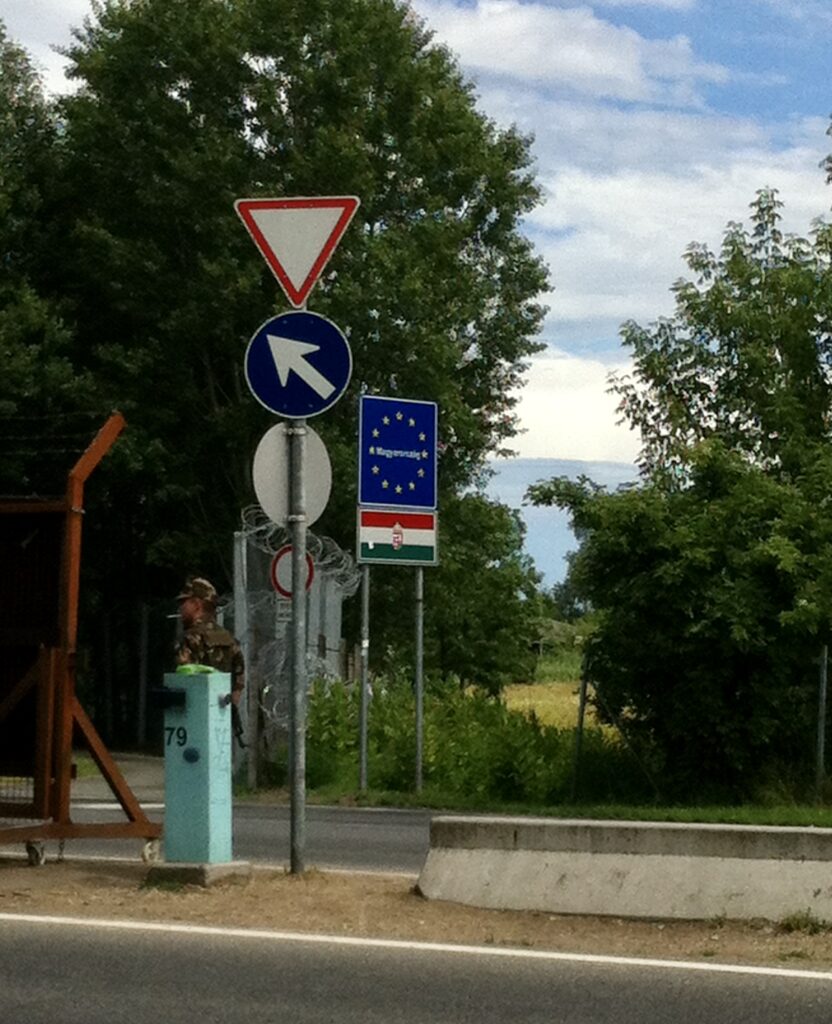
As a neighbour of Ukraine and Serbia (and, at the time, of Croatia and Romania, which were not yet members of the European Union), Hungary was given a key role in this EU border protection regime. This ‘frontline’ positioning was taken extremely seriously by the government. According to Sándor Illés and Attila Melegh, Hungarian authorities were particularly zealous in the area of border control, seeing it as an opportunity to showcase their dedication to the European project.[9] The administration at the time was keen to emphasise the way in which, by doing so, the country was reconnecting with its historical tradition. In 2009, Krisztina Berta, then head of consular services at the Hungarian Ministry of Interior – responsible for the implementation of Hungary’s new visa policy – explained that the country had once again become the “last line of defence of Western Europe vis-à-vis the East.”[10] Control of the border involved a symbolic and material distancing from the ‘East,’ allowing Hungary to fully inscribe itself in the ‘West’ and to firmly locate itself within the new political geography of the region.
Returning to Europe?
This positioning is in perfect alignment with what I have described elsewhere as ‘Europeanism,’ i.e. a discourse that attributes to Europe a shared civilisational and moral identity, often considered to be rooted in a Christian heritage, and characterised by a natural tendency towards liberal democracy.[11] This self-representation of Europe as a community of values is built around various categories of Otherness which, through their exclusion, establish the putative boundaries of this imagined community. Among them, the fantasised figure of a dangerous migrant, threatening to infiltrate and distort ‘European culture’ and drawing on Orientalist tropes, has played a key role in the construction of Europe.[12] Europeanism is thus underpinned by what Edward W. Said calls ‘imaginative geographies,’ i.e. a vision of the world as composed of both noble and decadent spaces, of territories to be valued and others to be developed or fought against. These imaginative geographies, Said explains, are based on normative and asymmetrical spatial ideologies, and proceed from unequal power relations.[13]
With regard to Hungary, and Central and Eastern Europe more broadly, one of the manifestations of this Europeanist rhetoric in the 1980s was carried by liberal Eastern bloc intellectuals like Milan Kundera seeking to revive the idea of Mitteleuropa.[14] This German notion, of which there are different ideological conceptions as well as geographical definitions, dates back to the nineteenth century. It has historically been associated with the goal of creating a unified, liberal economic space in Central Europe. In the 1980s, this idea of a Middle Europe clearly belonging to the West, but stretching along the Danube, served as a ‘bridging-concept’ for EU enlargement. The discourse on Mitteleuropa presented the countries of Central Europe as victims of a “political kidnapping” by the Eastern bloc, even though their identity is “culturally Western.”[15] The discourse thus shifted the contours of the Cold War’s imaginative geography by including Central Europe in a renewed vision of the West. It also gave particular meaning to the difficulties generated by the transition processes, which were no longer objective signs of the effects of regime change, but portrayed as sacrifices justified by a desire to ‘return’ to a Christian, liberal, and capitalist Europe.
Beyond the fictional nature of the narrative of a liberal and universalist European moral identity, it also leads to what Dino Murtic calls a “chain of European alterities.”[16] Taking the example of former Yugoslavia, Murtic illustrates how identity-based discourses lead to the production of divisions and hierarchies within Europe: for example, Croatian nationalist discourse is anchored in a representation of Catholic Europe, in opposition to the Orthodox Christianity of its Serbian neighbour, which in turn defines itself as European in opposition to Bosnian and Kosovar Islam. In fact, it is also often in the name of an ‘authentic’ European culture that we see today the return of anti-Semitic and anti-Roma discourses in Eastern European countries. The irony of this competition for Europeanness is all the more striking given that, in the West, the whole of Central Europe is at best a second-class Europe.[17]
Thus, the ‘transition’ to liberal, market-based capitalism and the entry of Central and Eastern European countries into the EU are the subject of a double discourse: the vision that sees it as a process of return to the historical home is opposed by a rhetoric according to which the process is already defeated, for these countries are seen as too far from the Europeanist ideal. In any case, Central and Eastern European countries must constantly demonstrate their willingness to act as good pupils of Europe and redouble their efforts in the hope of matching their Western counterparts. A striking example of the internalization of this infantilizing discourse by post-socialist political elites is provided in the Diplomata interview already mentioned, when Krisztina Berta boasts that Hungary’s performance in border control earned the country “an excellent grade in school.”[18]
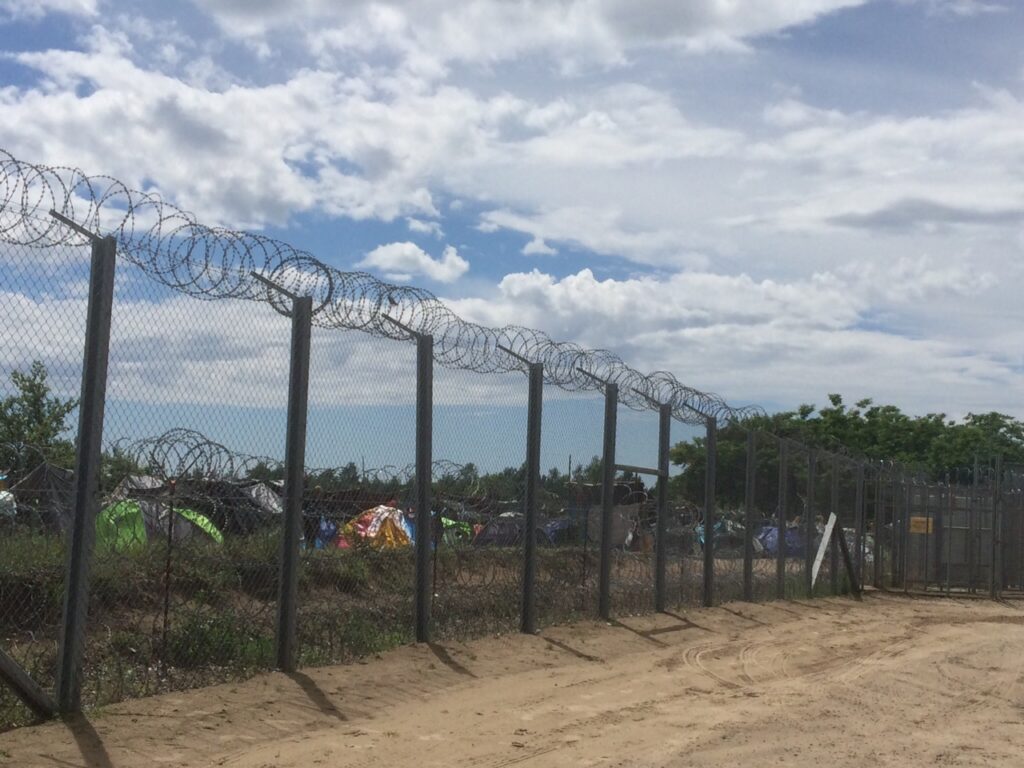
Analysing the articulation between the civilisational myth of a virtuous Europe to be defended against the migratory threat and the subaltern position of the new Schengen countries thus allows us to grasp Hungary’s investment in the role of defending a ‘white’ and ‘Christian’ Europe. From this perspective, we can rethink the country’s migration policy not as a radical break or moral anomaly from the rest of Europe, but rather as the exacerbation of trends characterising the EU accession process and as the result of the country’s specific position within the European space.
Paradoxes of Europeanism
Viktor Orbán’s anti-EU campaigns may appear paradoxical at first glance. Indeed, since 2015, his government has invariably opposed any migration management project emanating from Brussels, invoking, on the one hand, a lack of democracy in decision-making at the supranational level and, on the other, the sovereign right of countries to decide who enters their territory. In December 2015, supported by the head of the Slovak government, Viktor Orbán filed a lawsuit against the provisional compulsory relocation mechanism for asylum seekers adopted three months earlier by the EU Council of Ministers. This was accompanied in Hungary by a referendum to show the public’s opposition to the relocation mechanism. Held on 2 October 2016, after a virulent campaign featuring anti-immigration posters and discourses targeting EU institutions, the results of the referendum were not given legal force due to low turnout.[19]
Yet, far from marking a turn away from ideas of Europe, Orbán’s anti-EU positions have in fact been legitimised in the name of preserving Europeanness and Europe’s “Christian heritage.” In this discursive configuration, Orbán argues that “Brussels was in a grip of madness” and was “no longer able to protect Europe,” therefore justifying the need for Hungary to propose an alternative European leadership. In doing so, he constructs an image of the country as a new European vanguard, better able to protect Europe, than EU institutions and Western member states. In other words, Orbán has invested the realm of migration policy as a political battleground within which to contest intra-European hierarchies, and through which to renegotiate Hungary’s weight in European decision-making processes.
Culturalising capitalism: moral economies of illiberalism
Thus, Hungary’s anti-immigration stance is not so much the result of a moral anomaly, but rather the expression of pragmatic political manoeuvring, aimed at specific objectives in the context of the EU. The political trajectory of Viktor Orbán and of his Fidesz party, which was fiercely pro-liberal democracy in 1989 and has since been transformed into a champion of ‘illiberalism,’ reflects this political opportunism. One of the first uses of the term ‘illiberal democracy’ in the Hungarian context was in 2014, when Viktor Orbán gave a speech to a group of young Hungarians in Romania. Illiberalism as he describes it is a mode of political organisation aimed at making the state more economically competitive. In order to do this, a number of obstacles to competitiveness must be removed, including civil society organisations, non-governmental organisations (NGOs), and social movements that would slow down the country’s performance.[20] Viktor Orbán’s illiberalism is thus a process of redefining the political community, according to the notion that only those who contribute to making the state competitive are legitimate members of the ‘nation.’[21] In the context of the transition to a market economy and the global financial crisis, this competitiveness is defined primarily by the ability of the country to catch up economically with Western Europe and, more broadly, to become competitive in the world economy. Its development trajectory and the political form this has generated are thus the product of the specific position of Hungary in the European semi-periphery.

In this perspective, individuals and social groups considered as unproductive and identified as slowing down the state, become undesirable groups, which need to be neutralised through segregation measures. Since 2014, reforms aimed at the unemployed, the homeless, people with disabilities, and Roma communities, already heavily stigmatised by racist tropes, have been adopted, in order to further socially and economically marginalize these populations. Although ‘migrants’ were not yet part of the conservative rhetoric at the time, the mechanisms and devices deployed from 2015 onwards to exclude them were already well in place with different groups as targets. These positions, decried as being far from “European values” by EU government leaders, are thus in part the product of the political and ideological processes at work in the transformation of the Central European economies, and directly tied to their integration into the capitalist mode of production within the EU. Moreover, these positions have borne fruit politically, as Viktor Orbán has established himself as a key figurehead of an ultraconservative European right-wing that is gaining in popularity with the rise of identity and security rhetoric across Europe.
Broadening this approach through an intersectional analytical framework is also of key importance. For instance, an area where capitalist moral order is combined with ultraconservative politics is family law, which has undergone several reforms in recent years. Most recently, the Family Law of 2020 aims to intervene in the management of Hungary’s demography by encouraging births. It is rooted in the traditional family and values domestic work for women. Conservative gender roles are promoted through incentives (including tax incentives) that reward heterosexual couples and women with children. These amendments are accompanied by attacks on LGBTQI+ communities, as well as assaults on gender studies and feminist movements. In 2020, a constitutional reform outlawed adoption by same-sex couples and enshrined in the Constitution a definition of family as ‘based on marriage and the bond between parents and children, where the mother is a woman and the father a man.’ Decried in the rest of the EU as further evidence of Hungary’s retrograde character, we can see how this moralisation of sexuality – so that it has as its sole objective the social reproduction of a competitive ‘nation’ – is also a specific response to the contradictions produced by the country’s place in the economic organisation of Europe, and the transnational division of labour that results from it.
The moral economy (by which I mean the regime of desirable and undesirable subjectivities that accompanies relations of production) underlying this illiberal vision nevertheless generates certain contradictions. Several elements need to be analysed in order to understand its impact on migration policy. First, since 2015 in particular, Hungary suffers from a severe labour shortage, aggravated by its refusal to accept migrants. This labour shortage is linked to severe demographic decline, coupled with the continuous increase in emigration to western EU countries over the last decade.[22] According to Eurostat data, the percentage of working-age people residing in another EU country rose from 1.2 to 4.5% of the population between 2010 and 2020.[23] Anticipating the labour shortages, Hungary has attempted to promote the ‘return’ of those considered ‘ethnic Hungarians’ (mostly groups identifying themselves as Hungarians but who were separated from the country when it was carved up in 1921 and who are de facto residents of neighbouring countries like Serbia, Romania, Slovakia, and Ukraine). For example, a law on citizenship adopted in 2010 allows people whose ancestors had Hungarian citizenship to acquire it without the condition of residence in the country.[24]
Secondly, these contradictions have led to new forms of transnational labour organisation. For example, for several years, there has been an increase in the number of ‘temporary work agencies,’ which act as brokers between states and/or different companies with factories in Central European countries, in order to provide cheap labour.[25] This system has gained further traction in the wake of the COVID-19 pandemic, during which the employment of third-country nationals through temporary work agencies was extended and simplified. In particular, a decree adopted in July 2021 places the responsibility for the employment of third-country nationals under the Minister of Foreign Affairs and Trade, and provides for further derogations regarding labour law.[26] These agencies (or, often, subcontractors) are active in neighbouring countries, in particular Serbia and Ukraine, from where they offer ‘compatible’ workers, to quote Viktor Orbán’s expression, for short and determined periods. Moreover, this mechanism is intrinsically linked to the specific economic organisation of the European space and the regional division of labour that underlies it. For example, in Hungary, agencies provide workers for the car industry, i.e. for factories assembling cars or producing different parts used to build cars in Germany at low cost.[27] The relocation of the German car industry to the East thus requires the availability of cheap and hyperflexible labour, while low wages push Hungarians to seek work elsewhere in Europe, by virtue of their participation in the free movement area. The use of temporary agencies allows the country to resolve this contradiction, since its anti-immigration stance prevents it from turning to workers from the eastern and southern peripheries of Europe, which usually provide this type of labour to the rest of the EU.
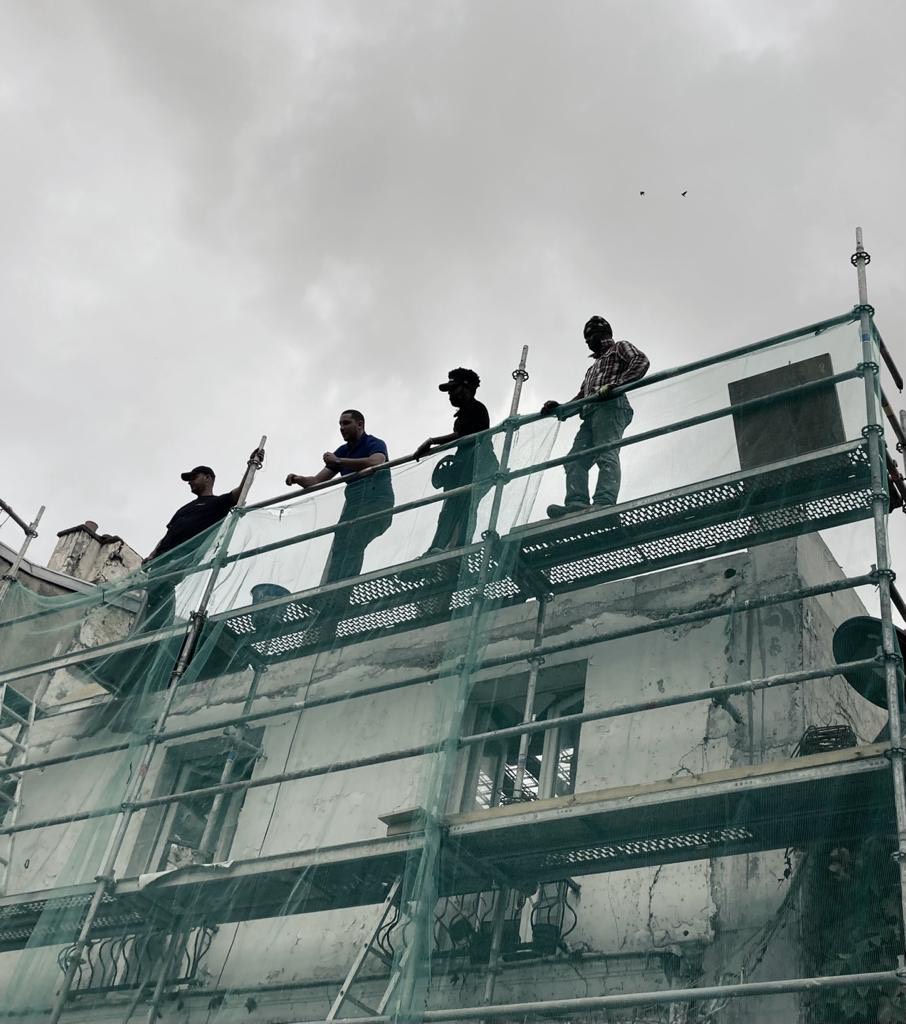
As a result, despite a shortage of labour, there is competition for jobs between Hungarians and “migrants.” However, this competition is not only played out on the local labour market but also in Western Europe, particularly in Germany, the main place of residence of Hungarian migrant workers and the first country to receive refugees in 2015. Viktor Orbán stressed this point in 2017 during a meeting with Chancellor Angela Merkel, demanding that Hungarians continue to enjoy privileged access to the German labour market, in the name of their membership of the European community. The stakes are high, since remittances from migrants account for a growing share of the Hungarian economy. Between 2016 and 2019, it was estimated that they represented between 3 and 4% of the GDP.[28]
Thus, the new conservative moral order in Hungary is first and foremost a product of the economic organisation of the European community, and the contradictions it generates. It aims to redefine social relations in order to put them at the service of the transition to capitalist modes of production and the insertion of the country into a transnational division of labour. In this perspective, the virtuous citizen is above all a productive citizen. The multiple legal and constitutional reforms adopted over the last decade are largely oriented towards this goal: that the law should be used as a lever to reshape and mobilise the political community in defence of economic interests. While the exclusionary measures targeting migrants since 2015 have been treated as moral issues in European political discourse, they are actually part of a broader capitalist moral economy, and are articulated with reforms targeting other social groups. For example, in December 2018, a bill was passed allowing employers to demand up to 400 hours of overtime per year from their employees and to delay payment for these hours for three years, despite an unprecedented wave of protest. The rhetoric surrounding the passage of the bill included claims that it would allow workers to work domestically, rather than finding employment opportunities abroad.[29]
Conclusion
In sum, Hungary’s radically exclusionary migration policy is articulated towards a societal project that seeks to meet the demands of the economic and political organisation of the EU and the global economy. By anchoring our analysis in this broader context, we can therefore see a common logic to a broad range of public policies, including those related to migration. This moralisation of politics, which instrumentalises a radical anti-immigration stance in the context of political manoeuvring on a national and European scale, can only be understood in the light of a materialist and structural analysis of the transformations of these countries over the last three decades.
Read the article in CEE languages on ELMO member platforms:
- in Hungarian on Mérce
- in Ukrainian on Spilne/Commons
- in Serbo-Croatian Mašina and Radnička prava
- in Romanian on Platzforma and Gazeta de Artă Politică
- in Bulgarian on Baricada Bulgaria and dVersia
Subscribe to ELMO’s newsletter here.
[1] For an analysis of the openly anti-liberal and populist ideological positions of the Hungarian post-socialist elites and how they connect with global hierarchies and popular frustration over these global hierarchies see GAGYI, A. (2016), ““Coloniality of power” in East Central Europe: external penetration as internal force in post-socialist Hungarian politics, Journal of World-Systems Research, 22(2):349-372.
[2] AGENCE FRANCE PRESSE, “Refugee influx threatens Europe’s Christian identity, says Viktor Orbán,” Le Soir, September 3, 2015, https://www.lesoir.be/art/
979707/article/actualite/union-europeenne/2015-09-03/l-afflux-des-refugies-menace-l-identite-chretienne-l-europe-selon-viktor-or .
[3] BBC News, “Migrants: Merkel and Orban Clash over Europe’s ‘Humanity'”, July 5th 2018, https://www.bbc.com/news/world-europe-44728577.
[4] I have expanded elsewhere on the political economy of discourses around Europe and European belonging. See: CANTAT, C. (2016) “The ideology of Europeanism and Europe’s migrant other”, International Socialism, October 2016, Issue 152.
[5] DUEZ, Denis, The European Union and Illegal Immigration. De la sécurité intérieure à la construction de la communauté politique, Brussels: Éditions de l’Université de Bruxelles, 2008, 288 p., http://digistore.bib.ulb.ac.be/2016/i9782800414164_f.pdf
[6] The European Border and Coast Guard Agency, established by Regulation (EU) 2016/1624 of 14 September 2016 on the European Corps of Border and Coast Guards, replaced the European Agency for the Management of Operational Cooperation at the External Borders of the Member States of the EU. It has the same legal personality and is known by the same name: Frontex.
[7] RODIER, Claire, “Externalisation de l’asile: concept, évolution, mécanismes”, in: GISTI, Le droit d’asile à l’épreuve de l’externalisation des politiques migratoires, Paris: Gisti, 2020, pp. 19-34, http://www.gisti.org/publication_pres.php?id_article=5383.
[8] The Schengen Borders Code refers to Regulation (EC) No 562/2006 of the European Parliament and of the Council of 15 March 2006 establishing a Community Code on the rules governing the movement of persons across borders. See: DARLEY, Mathilde, “Le contrôle migratoire aux frontières Schengen : pratiques et représentations des polices sur la ligne tchéco-autrichienne”, Cultures & conflits, no 71, Autumn 2008, pp. 1329-.
[9] ILLÉS, Sandor ; MELEGH, Attila, Hungary in the Schengen System: Bastion or Gateway? Qualitative and Quantitative Analysis of the Schengen-based Visa System and Visa Issuance Practice in Hungary, Budapest: Hungarian Europe Society, 2010, 32 p.
[10] DIPLOMATA, Interview with Dr. Krisztina Berta, Head of the Consular Department of the Ministry of Foreign Affairs, No. 1, 2009, http://www.diplomatamagazin.hu/ftp/gh1uarh_18-20.pdf.
[11] CANTAT, Céline, Contesting Europeanism: Discourses and Practices of Pro-Migrant Organisations in the European Union, PhD Thesis in Social Sciences, London: University of East London, 2015, 334 p., https://doi.org/10.15123/PUB.4618.
[12] Ibid.
[13] SAID, Edward W., Orientalism. L’Orient créé par l’Occident, Paris: Éditions du Seuil, 2005, 430 p.; See also: BERDOULAY, Vincent, “Préface”, in: DUPUY, Lionel; PUYO, Jean-Yves (ed.), L’imaginaire géographique. Entre géographie, langue et littérature, Pau: Presses de l’Université de Pau et des pays de l’Adour, 2014, 178 p.
[14] GODEFFROY, Gabriel, “Entre Mitteleuropa et Paneuropa : le projet d’Elemér Hantos dans l’entre-deux-guerres”, Bulletin de l’Institut Pierre Renouvin, No. 43, Spring 2016, pp. 63-74 ; DELANTY, Gérard, “The Resonance of Mitteleuropa: A Habsburg Myth or Antipolitics?”, Theory, Culture & Society, Vol. 13, No. 4, 1996, pp. 93-108
[15] KUNDERA, Milan, “The Tragedy of Central Europe”, New York Review of Books, Vol. 31, No. 7, 1984, https://www.nybooks.com/articles/1984/04/26/the-tragedy-of-central-europe/.
[16] MURTIC, Dino, Post-Yugoslav Cinema: Towards a Cosmopolitan Imagining, London: Palgrave MacMillan, 2015, 207 p.
[17] KOUVELAKIS, Stathis, The Defeated Critic. Emergence and Domestication of Critical Theory, Paris: Éditions d’Amsterdam, 2019, 536 p.
[18] DIPLOMATA, art. cit.
[19] For a more in-depth analysis of the variegated Hungarian’s public responses and their political implications, see FEISCHMIDT Margit and ZAKARIÁS Ildiko (2019) Politics of care and compassion: Civic help for refugees and its political implications in Hungary: A mixed-methods approach. In: Feischmidt M, Pries L, Cantat C (eds) Refugee Protection and Civil Society in Europe. Cham: Palgrave Macmillan, pp. 59–99.
[20] MAHONY, Honor, “Orban Wants to Build ‘Illiberal State'”, EU Observer, July 28th 2014, https://euobserver.com/political/125128.
[21] CANTAT, Céline; RAJARAM, Prem Kumar, “The Politics of the Refugee Crisis in Hungary: Bordering and Ordering the Nation and Its Others”, in: MENJÍVAR, Cecilia; RUIZ, Marie; NESS, Immanuel (eds), The Oxford Handbook of Migration Crises, Oxford: Oxford University Press, 2018, pp. 181-195, https://www.oxfordhandbooks.com/view/10.1093/oxfordhb/9780190856908.001.0001/oxfordhb-9780190856908-e-69.
[22] MELEGH, Attila, “Unequal Exchanges and the Radicalization of Demographic Nationalism in Hungary”, Intersections. East European Journal of Society and Politics, Vol. 2, No. 4. 2016, pp. 87-108, https://doi.org/10.17356/ieejsp.v2i4.287.
[23] Emigration from Hungary did not rise sharply in the 1990s, but it accelerated quickly following the country’s economic recession in 2006, and worsened with the financial crisis and the collapse of many households’ foreign currency loans. This has been compounded by severe cuts in social benefits since 2011. See Eurostat data: https://ec.europa.eu/eurostat/statistics-explained/
index.php?title=EU_citizens_living_in_another_Member_State_-_statistical_overview.
[24] See for example: LOSONCZY, Anne-Marie, “Ritualisation mémorielle et construction ethnique postcommuniste chez les Hongrois de Transcarpathie (Ukraine)”, Civilisations, vol. 59, n° 1, 2010, pp. 131-150, https://doi.org/10.4000/civilisations.2248.
[25] MESZMANN, Tibor; FEDYUK, Olena, Temporary Agency Work as a Form and Channel of Labour Migration in Hungary, Budapest: Friederich Ebert Stiftung, 2020, 8 p., https://library.fes.de/pdf-files/bueros/budapest/14597.pdf.
[26] For an update of recent developments, see MESZMANN, Tibor (2022) BARMIG Project, National Report Hungary, available: https://phavi.umcs.pl/at/attachments/2022/0210/132728-barmig-hu-final-report-pdf-version.pdf
[27] GAGYI, Agnes; GERŐCS, Tamás; SZABÓ, Linda; SZARVAS, Márton, “Beyond Moral Interpretations of the EU ‘Migration Crisis’: Hungary and the Global Economic Division of Labor”, LeftEast, February 9th 2016, https://lefteast.org/beyond-moral-interpretations-of-hu-eu-migration-crisis/
[28] While they were below 0.5% of GDP until 2003, remittances from Hungarian emigrants reached 1.6% from 2004 (with EU accession) and have been increasing steadily ever since. See: WORLD BANK, Remittance Inflows to GDP for Hungary, St. Louis: Federal Reserve Bank of St. Louis, https://fred.stlouisfed.org/series/DDOI11HUA156NWDB.
[29] GAGYI, Agnes; GERŐCS, Tamás; SZABÓ, Linda; SZARVAS, Márton (2016, opus cited)

Céline Cantat holds a PhD in Social Sciences from the University of East London, an MSc in Globalisation and Development from SOAS, University of London, and a BA in European Studies from King’s College London. She is currently Academic Director and Lecturer at Sciences Po Paris. Previously, Céline worked as Academic Director of a higher education access programme for refugee students and as a Marie Curie Individual Fellow studying solidarity mobilisation with and by refugees along the Balkan route at the Central European University in Budapest. Her research has focused on migration, humanitarianism, solidarity mobilisation and the relation between macro processes, such as globalisation and state formation, and the forced movement of people within and across borders.

